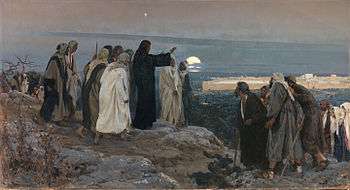Dominus Flevit Church
| Dominus Flevit Church | |
|---|---|
 View from the Courtyard | |
| Basic information | |
| Location | Jerusalem |
| Affiliation | Roman Catholic |
| Leadership | Franciscan Order |
| Architectural description | |
| Architect(s) | Antonio Barluzzi |
| Completed | 1955 |
Dominus Flevit is a Roman Catholic church on the Mount of Olives, opposite the walls of the Old City of Jerusalem. The church was designed and constructed between 1953 and 1955 by the Italian architect Antonio Barluzzi and is held in trust by the Franciscan Custody of the Holy Land. During construction of the sanctuary, archaeologists uncovered artifacts dating back to the Canaanite period, as well as tombs from the Second Temple and Byzantine eras.
History
Dominus Flevit, which translates from Latin as "The Lord Wept", was fashioned in the shape of a teardrop to symbolize the tears of Christ. Here, according to the 19th chapter of the Gospel of Luke, Jesus, while riding toward the city of Jerusalem, becomes overwhelmed by the beauty of the Second Temple and predicting its future destruction, and the diaspora of the Jewish people, weeps openly (an event known as Flevit super illam in Latin language). (Luke 19:37-42)
The site of Christ's weeping was unmarked until the Crusader era. It was during this time that people began commemorating the site. Eventually a small chapel was built there. After the fall of Jerusalem in 1187, the church fell into ruin. In the early sixteenth century a mosque or madrasah existed at the site, presumably built by the Turks, from the remains of the earlier church, although the exact use is disputed. This place was known as el Mansouriyeh (The Triumphant) and also el Khelweh (The Hermitage).
The Franciscans were unable to obtain the ruins, so, in 1891 they purchased a small plot of land nearby and built a small chapel there. In 1913 a small private home was built in front of the Franciscan chapel by one Miss Mellon. This home eventually passed to the Sisters of St. Joseph, who eventually sold it to a Portuguese woman.
Archaeology
In 1940, the Benedictine Sisters sold part of the property to the Franciscans. The old boundary wall was moved at this time to make the division. In 1953 the Franciscans began construction of another wall. While digging the foundations, workers unearthed ancient tombs. Excavations began at the site, led by Fr. Bellarmino Bagatti, OFM.
A late Bronze Age tomb from the Canaanite period, as well as a necropolis used from 136 BC to 300 AD were discovered. The necropolis spanned two separate periods, characterized by differing tomb styles. The earlier Second Temple era tombs were of the Kokhim style, while the Byzantine era section was composed of tombs with arcosolium from the 3rd and 4th centuries AD. A Byzantine monastery from the 5th century was also discovered. Mosaics from this monastery still remain at the site.
Picture gallery
- Side view of Dominus Flevit Church
- Mosaic and cross on the floor
- View from west
- Ossuary
 Mosaic Art on altar
Mosaic Art on altar "Flevit super illam" (He wept over it) by Enrique Simonet, 1892
"Flevit super illam" (He wept over it) by Enrique Simonet, 1892
External links
![]() Media related to Dominus Flevit Church at Wikimedia Commons
Media related to Dominus Flevit Church at Wikimedia Commons
- Dominus Flevit: history of the site
- Dominus Flevit — Jerusalem Photos Portal
- The Franciscan Custody of the Holy Land
- VR Panoramic Images of Dominus Flevit Church
Further reading
- Bellarmino Bagatti and Milik, 1968. Gli scavi del Dominus Flevit An account of the excavations, 1953-55.
Coordinates: 31°46′41″N 35°14′30″E / 31.77806°N 35.24167°E